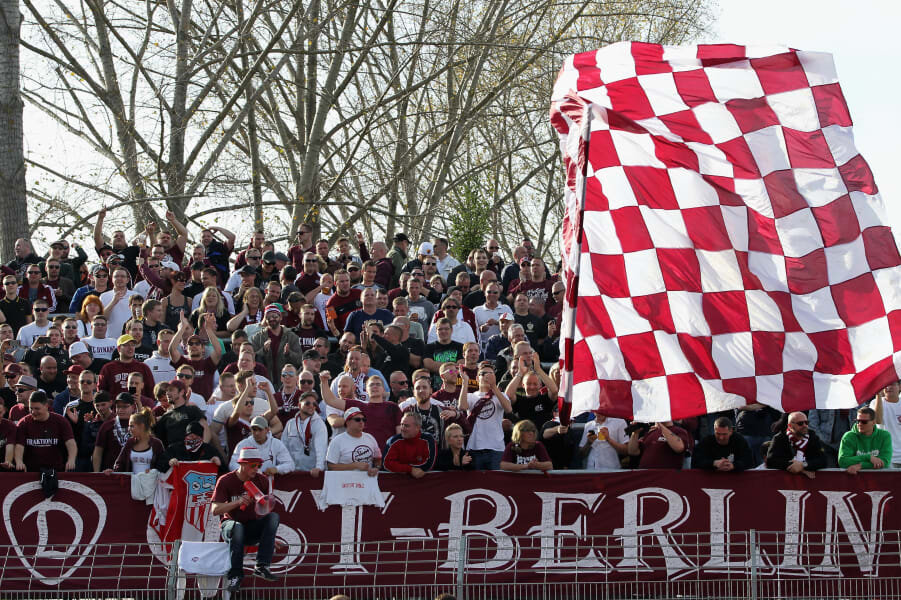Club VII | Berliner FC Dynamo
As if Berlin wasn’t already unique enough, it is also something of a peculiarity from a footballing perspective.
European capital cities tend to be the home of one of (or several of) the country’s most successful clubs. Madrid has Real, Amsterdam has Ajax, London has Chelsea, Arsenal and Tottenham, and Rome has Roma and Lazio. Whilst there are two Berlin sides in this season’s installment of the Bundesliga, this is something of a rarity. In fact, there have only been six competitive games between Hertha BSC and Union Berlin: The two sides who are largely thought to be Berlin’s most famous clubs.
Whilst the modern day “Berlin Derby” is played out between Hertha and Union, the two sides only emerged as the city’s dominant sides in the wake of the fall of the Berlin Wall. The fall of the Berlin Wall would prove to be the beginning of the end for this week’s subject.
So then, Berliner FC Dynamo: Who are they?
Berliner FC Dynamo, BFC, or simply Dynamo Berlin, is a German football club based in East Germany. Nicknamed Die Weinroten (The Clarets), they play their trade in the Regionalliga Nordost, the fourth tier of German football. They play their home games at Friedrich-Ludwig-Jahn-Sportpark, situated in the locality of Prenzlauer Berg, which is just about as East Berlin as it gets. So then, before the fall of the Berlin Wall and the subsequent fall from grace of BFC, just how good were they?
10-in-a-Row: BFC Dynamo dominated East German football during the 1980s | Photo Credit
The club was formed in 1966 as an offshoot of SC (Sports Club) Dynamo Berlin. The word “Dynamo” in the club’s name is of particular importance. You may have heard of teams such as Dynamo Dresden before and wondered what exactly this referred to.
All clubs bearing the word “Dynamo” were originally members of SV Dynamo, the Sports Association for the security agencies. Head of SV Dynamo at the time of BFC’s founding, was none other than Erich Mielke. Yes, that Erich Mielke, the Deputy State Secretary of the Ministerium fuer Staatssicherheit (The East German Ministry for State Security, often referred to simply as the “Stasi”). Mielke was a huge football fan and BFC would soon become a source of pride and joy for him.
Friends in high places: BFC Dynamo would become the pride and joy of Stasi Chief, Erich Mielke | Photo Credit
BFC would quickly become a dominant force in the East German Oberliga (East Germany’s top tier). Between 1979 and 1988 they won ten consecutive league championships. Given the Stasi influence, it will perhaps not come as a surprise to you that some critics suspected foul play. As well as being a dominant force on home soil, the East Berliners would also make a name for themselves on the European stage.
In the 1979-80 installment of the European Cup, Dynamo reached the quarter finals where they would play Brian Clough’s Nottingham forest. Despite a valiant win at the City Ground (0-1), Dynamo were ultimately eliminated however after a 3-1 defeat in front of 30,000 spectators at Friedrich-Ludwig-Jahn-Sportpark. The win in Nottingham however was significant as it was the first occasion on which a German team defeated an English team on English soil in the European Cup.
Another European tie which bore quite some significance but for different reasons was their fixtures vs Hamburger SV during the 1982-83 season. The first leg was due to be played at Friedrich-Ludwig-Jahn-Sportpark but just as excitement was building, the Stasi announced restrictions on ticket sales. Due to Stasi fears of riots and political demonstrations, only 2,000 fans (Many of whom were Stasi officers) were allowed to attend instead of what would have been a sell-out crowd of 30,000+.
Dynamo travelled to Anfield in 1973 to take on Liverpool in a UEFA Cup Tie | Photo Credit
Okay, so Dynamo were referred to as the “Stasi Club” and the players and backroom staff underwent political training, but what about their fans? Robert Claus, an expert on right-wing extremism in German football, claims that even prior to reunification, a right-wing subculture existed on the terraces of Friedrich-Ludwig-Jahn-Sportpark.
If you are raising your eyebrow whilst reading this, you are not alone. It seems utterly incomprehensible, that right-wing extremism would be allowed to exist to any extent in the East German state.
A typical Dynamo matchday scene | Photo Credit
As BFC fell further down the German football pyramid, the Neo-Nazi influence became more and more palpable at the club. Hooliganism and violence became synonymous with the East Berlin side. Whilst the situation is perhaps not quite as severe as it was during the 90s and the atmosphere at Friedrich-Ludwig-Jahn-Sportpark is for the most part friendly, the authorities still view the fans as the most dangerous in the city. Almost 50% of police categorised “Hooligans” in Berlin are supporters of BFC.
In terms of fan friendships/connections, the most notably, there are links with Kaliber 030, a Hertha Berlin Ultras Group and also with fans of 1. FC Magdeburg.
When the world returns to some degree of normality and you have the chance to travel to Berlin, make sure to include a trip to see the record East German Champions on your itinerary. You’ll be hard pressed to find another club with such a unique history coupled with such a paradoxical fan identity.





